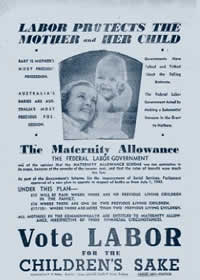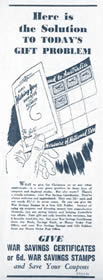
AUSTERITY, LIBERTY AND VICTORY
Man of his Word
I ask you to reconcile yourselves to a season of austerity, to make your habits of life conform to those of the fighting forces. The civil population can learn to discipline itself; it can learn to go without.
(John Curtin, August 1942)
Tough times at home
Until mid-1942 there were plenty of goods for Australian consumers to purchase. However, the advance of the Japanese, the arrival of large numbers of American troops, and the transfer of large quantities of goods, especially food, to Britain to help with the war effort, put a great strain on resources.
Rationing was introduced gradually from March 1942 as a solution to the problem of supplying adequate food and clothing to all Australians, to prevent hoarding and to divert resources towards the war effort.
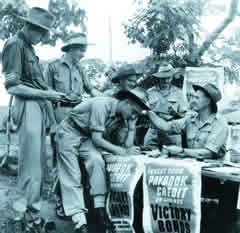
Soldiers buying bonds to support the war effort.
Courtesy of Argus Newspaper Collection of Photographs, State Library of Victoria: Accession No. H98.103/2669
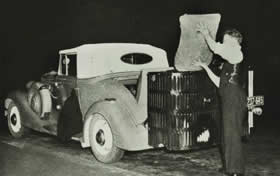
Charcoal burning gas producers were adopted by car owners wishing to make use of their cars. Courtesy Australian War Memorial: Negative No. 042820
Paying for the war
During the 1941-42 financial year, the last nine months of which were administered by the Curtin government, war expenditure reached £319 million of which £108 million came from taxes, £126 million in loans and War Savings certificates, £78 million in Treasury Bills and £6 million temporary use of available funds. By June 1943 the total cost of the war had reached £1,107 million which had been funded by £363 million in taxation (i.e. 33% of the total and more than three times the amount collected in tax two years earlier), £474 million in loans and £259 million in treasury bills.
This was at a time when the average male wage was £5/15/8 per week and women earned an average of £3/4/4 per week. Expressed as a percentage of national income defence expenditure rose from 11% in 1940-41 to 29% in 1941-42 and 43% in 1942-43.
You could not walk in and buy a chocolate. Just occasionally the grocer might furtively slip one small block (wrapped, but without any foil) into the bottom of a customer’s basket. The smoker was lucky to get his smokes, and often he went short. There were queues for beer. A whole day’s ration of butter was only about the size of a large tube of lipstick. Vegemite and marmite were early wartime casualties. In their place we were offered a sticky yellow muck in a blue tin, with salty crystals of preservative thick in the bottom. It was called Globex, and I am sure that it was made in Japan for the demoralization of Australians…[C]lothes buying [was] restricted by the coupon system…When we got a shirt it was a ‘Dedman’ – a shirt with no tail to speak of, bobbed like a Manx cat by order of the Hon. J J Dedman…To combat the petrol shortage, the comparatively few cars on the road were usually fitted with charcoal-burning gas-producers. These were Heath-Robinson contraptions, something like galvanized garbage cans…Car headlights were painted blue, leaving only a narrow slit clear. Street lights were out. Every window had blackout curtains.
(John Barrat, 1977).
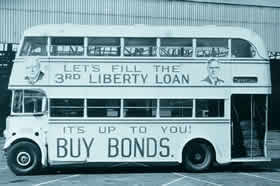
John Curtin Prime Ministerial Library. Records of the Curtin family. Liberty Bonds - double decker buses in Sydney depicting Churchill and Curtin. (n.d.). JCPML00376/130
New powers
Curtin was deeply interested in economic issues. On 19 February 1942 he announced a National Economic Plan which included pegging wages and profits, closing non-essential industries and taking control of manpower. He argued that only through unified national control could enough money be raised to prosecute the war effectively. In May 1942 the Commonwealth took responsibility for income tax, promising to compensate states if they refrained from imposing their own income taxes.
Four of the states challenged Commonwealth powers in the High Court but the legislation was upheld in a manner which implied that the power would continue even after the war. In 1957 a High Court decision effectively confirmed the 1942 judgment. Thus, the greatest single change in Australia’s constitutional and political structure was achieved without formal amendment of the Constitution.
To soften the blow of the higher Commonwealth income taxes, a series of social welfare measures were introduced, commencing with widows pensions in 1942. In the budget for 1943-44 the government announced it would commit £30 million to a newly established National Welfare Fund.
For the common wealth
Both private trading and State savings banks cooperated with the Commonwealth Bank during the war to organize domestic and international financial resources for the war effort. National Security Regulations gave the Commonwealth Bank the ability to provide a centralized and controlled banking system for Australia and 1945 legislation confirmed the Bank’s central banking control. It was directed to maintain policies that were of advantage to Australians, especially in maintaining the stability of the currency, full employment and economic prosperity.
American Aid
The Lend Lease Agreement signed by Australia and the US on 3 September 1942 aimed to provide the equipment necessary to further the war effort. Initially intended to help Great Britain, the program expanded to approximately 40 nations including China, the Soviet Union, Australia and New Zealand. Under its terms a reciprocal agreement was put in place whereby goods, machinery, services, shipping, and military installations were provided by the Americans to the Allied nations, to be paid for at the end of the war in goods and services. Total lend-lease aid exceeded US$50 billion, of which the British Commonwealth received some US$31 billion.
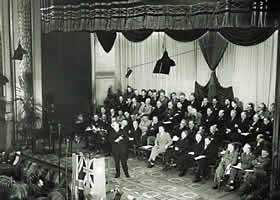
John Curtin Prime Ministerial Library. Records of West Australian News Ltd. Mr Curtin opening Austerity Loan at Capitol Theatre, 3/11/1942. JCPML00140/5. Original held by West Australian News Ltd: W2186.
No Santa Claus
John J Dedman, as the Minister for War Organization of Industry, was responsible for preventing the serious waste of manpower and materials. In 1942 he banned advertisers from using the words ‘Christmas’, ‘Yuletide’ or ‘festive season’ and there was to be no mention of Santa Claus. His contention was that Christmas was too ‘commercialised’ and his measures were simply returning Australians to the true spirit of Christmas. The government even suggested that adults limit their exchange of presents to giving war savings stamps and certificates.
‘Give War Savings Certificates’ advertisement in the Bulletin, 16 December 1942.
Courtesy National Library of Australia
POSTWAR PROSPERITY
In the first few years after the war the government was faced with the prospect of promoting ‘Australia’s national economic well-being in the new multilateral economic world order.’
(David Lee, 1995)
Jobs for all
Curtin did not want a return to the unemployment and depression that had occurred after the First World War. He believed in the idea of full employment for Australians which became the basic principle of Australia’s postwar reconstruction. In 1945 a White Paper on the topic was published which emphasised Keynesian economic principles linking employment with expenditure. Nearly a million demobilised men and women were absorbed into the civilian work force after the war.

Banking Hall, Commonwealth Bank Forest Place Perth 1950.
Battye Library: 008208D
Commonwealth dominance
From early 1942 Curtin was not only concerned with the progress of the war but with putting into place measures which would have a lasting effect on postwar Australia. The Commonwealth dominance of finance and taxation implemented through the Curtin Government’s uniform income taxation has become progressively significant in the six decades since the end of the war, as Federal Governments make extensive use of ‘tied grants’ which – under the terms of Section 96 of the Constitution – have to be spent as the Commonwealth specifies.
Curtin’s Government carried through a number of reforms to establish a federally-administered Australian welfare state. The resulting policies were ratified by referendum in 1946 under Prime Minister Ben Chifley. Until 1942 the Commonwealth had only paid aged and invalid pensions but by the end of the 1940s it also provided rehabilitation services, unemployment benefits, funeral benefits to pensioners and benefits to university students. The Curtin and Chifley Governments paved the way for future federal financing of tertiary education, road building and urban development and also took the first steps towards establishing a national health scheme embracing medical, hospital and pharmaceutical benefits – although a working scheme did not come fully into operation until the 1950s.
